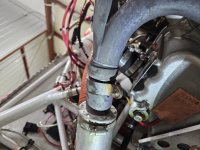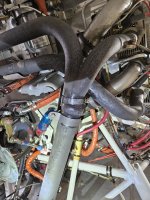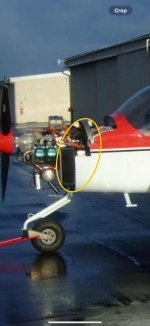So, determined the following today. The exhaust system leaks, but not inside the heat cuff. We put pressure into the exhaust and got significant leakage at every join - downstream from the ball joints, as well as at the straight join just below the headers, on both sides. The exhaust system is a Vetterman.

Leakage at top (right) of pipe clamp, just prior to ball joint. Ball joint does not leak itself.

Leakage at join on crossover pipe, right side of hose clamp visible on left side of photo. Also leaks at top of pipe clamp in center of photo. What looks like a crack in the middle of the top of the 'Y' on both the top pipe clamp and the pipe itself, is just a bad angle on the photo. No crack actually there.
Is some degree of leakage into the cowled area forward of the firewall just assumed to occur? A 'normal' condition? If I assume that the answer is yes, I am back to modifying the cabin's overall in/out flow profile. Firewall looked good - no obvious leaks. Also no easy way to put pressure on it to find any.
Pulled the tail access panels and will get in there with some RTV soon. Looking in/around the tailwheel spring mount pass through, primarily. Any/all holes on the bottom. Any other areas to look at let me know. I think I can also potentially seal a bit around the rudder cable pass-through conduits.
Will also install aileron push rod seals when they arrive, as well as working to seal off the upstream seams in the cowling to fuselage join (piano hinge and Skybolts) to prevent engine compartment gases seeping into NACAs, per recommendation. No easy way to do this inside the cowling, so may test fly a couple times before I resort to an external tape test, if a problem remains after the above efforts.
Lastly, I may also install weather strip along the back of the aft canopy skirt to see if that limits inflow. If none of this works, will advise and ask for more input. Only thing I can think of at that point is to throw out the Vetterman and buy an new exhaust. Consulted my builder and he indicated he was never pleased with the 1.5" exhaust system - thinks he got sold on a system that promised more than it delivered and wished he had gone with 1.75" pipes. Also, the crossovers seem more complex than necessary - why not just straight out? Recommends on folks to talk to about the exhaust system? I figured I would call Powerflow and let them try to sell me, just to learn at least.
Oh, and I got my first oil change done, with help from my A&P. Fifty flight hours since purchase, going strong and still grinning!








